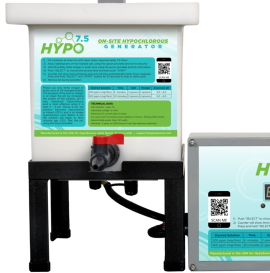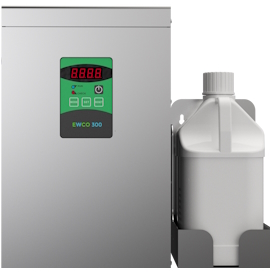Исследование > Индустрия > Health > Применение: Dental
Часто используемые названия для растворов хлорноватистой кислоты
- Electrolytically Generated Hypochlorous Acid
- Neutral Electrolyzed Water (NEW)
- Electrolyzed Oxidizing Water (EOW)
- Electro-chemically Activated Water (ECA)
- Super-oxidized water (SOW)
Результаты: 6 опубликованные статьи

Microbe(s): Enterococcus faecalis
Introduction This study evaluated the bactericidal effect of strong acid electrolyzed water (SAEW) against flow Enterococcus faecalis biofilm and its potential application as a root canal irrigant. Methods Flow E. faecalis biofilms were generated under a constant shear flow in a microfluidic system. For comparison, static E. faecalis biofilms were generated under a static condition on coverslip surfaces. Both the flow and static E. faecalis biofilms were treated with SAEW. Sodium hypochlorite (NaOCl, 5.25) and normal saline (0.9) were included as the controls. Bacterial reductions were evaluated using confocal laser scanning microscopy and the cell count method. Morphological changes of bacterial cells were observed using scanning electron microscopy. Results The confocal laser scanning microscopic and cell count results showed that SAEW had a bactericidal effect similar to that of 5.25 NaOCl against both the flow and static E. faecalis biofilms. The scanning electron microscopic results showed that smooth, consecutive, and bright bacteria surfaces became rough, shrunken, and even lysed after treated with SAEW, similar to those in the NaOCl group. Conclusions SAEW had an effective bactericidal effect against both the flow and static E. faecalis biofilms, and it might be qualified as a root canal irrigant for effective root canal disinfection.

Microbe(s): Escherichia coli, Porphyromonas gingivalis, Enterococcus faecalis, Streptococcus sanguinis
Chemotherapeutic agents have been used as an adjunct to mechanical debridement for peri-implantitis treatment. The present in vitro study evaluated and compared the effectiveness of hypochlorous acid (HOCl), sodium hypochlorite (NaOCl), and chlorhexidine (CHX) at eliminating Gram-negative (E. coli and P. gingivalis) and Gram-positive (E. faecalis and S. sanguinis) bacteria. The effect of irrigating volume and exposure time on the antimicrobial efficacy of HOCl was evaluated, and a durability analysis was completed. Live/dead staining, morphology observation, alamarBlue assay, and lipopolysacLPS) detection were examined on grit-blasted and biofilm-contaminated titanium alloy discs after treatment with the three chemotherapeutic agents. The results indicated that HOCl exhibited better antibacterial efficacy with increasing irrigating volumes. HOCl achieved greater antibacterial efficacy as treatment time was increased. A decrease in antimicrobial effectiveness was observed when HOCl was unsealed and left in contact with the air. All the irrigants showed antibacterial activity and killed the majority of bacteria on the titanium alloy surfaces of biofilm-contaminated implants. Moreover, HOCl significantly lowered the LPS concentration of P. gingivalis when compared with NaOCl and CHX. Thus, a HOCl antiseptic may be effective for cleaning biofilm-contaminated implant surfaces.

Oral Surgery, Oral Medicine, Oral Pathology, Oral Radiology, and Endodontology 107.2 (2009): 295-298
Microbe(s): Enterococcus faecalis
Objective: The purpose of this study was to determine the antimicrobial efficacy of sodium hypochlorite adjusted to pH 12, 7.5, and 6.5 in human root canals infected by Enterococcus faecalis. Study design: One hundred sixty-five human single-rooted teeth were prepared and inoculated with E. faecalis for 48 h. Teeth were divided into 3 experimental groups according to the irrigation pattern used: group 1, 4.2% NaOCl pH 12; group 2, 4.2% NaOCl pH 7.5; and group 3, 4.2% NaOCl pH 6.5. Samples from the root canals were collected, and bacterial growth was analyzed by turbidity of the culture medium. Results: None of the irrigating solutions used in this study demonstrated 100% effectiveness against E. faecalis. The antibacterial effectiveness of 4.2% NaOCl at pH 6.5 was significantly increased (P = .03) compared with 4.2% NaOCl at pH 12 (chi-squared test: P < .05). Conclusion: Bactericidal activity of NaOCl solution is enhanced by weak acidification of 4.2% NaOCl solution at pH 6.5.

Microbe(s): Total Microbial Count
This study investigated the antibacterial effect of electrolyzed water on oral bacteria both in vitro and in vivo. Tap water was electrolyzed in a water vessel using platinum cell technology. The electrolyzed tap water (called Puri-water) was put in contact with five major periodontopathogens or toothbrushes contaminated with these bacteria for 30 sec. In addition, Puri-water was used as a mouthwash for 30 sec in 16 subjects and the antibacterial effect on salivary bacteria was evaluated. Puri-water significantly reduced the growth of all periodontopathogens in culture and on toothbrushes, and that of aerobic and anaerobic bacteria in saliva, when compared to the effect of tap water. It also significantly reduced mutans streptococci growing on mitis salivarius-bacitracin agar. Our results demonstrate that the electrolyzed tap water is effective as a mouthwash and for toothbrush disinfection.

Microbe(s): Staphlycoccus Aureus
Electrolyzed strong and weak acid waters have been widely used for sterilization in clinical dentistry because of their excellent bactericidal activities. Electrolyzed neutral water was recently developed with a new concept of long-term good durability in addition to the excellent bactericidal activity similar to acid waters. The present study, evaluated the storage life of this water compared with the acid waters in terms of the changes in pH, oxidation-reduction potential (ORP), residual chlorine and bactericidal activity under several conditions using Staphylococcus aureus 209P. The strong acid water showed a rapid deterioration of its bactericidal activity. The weak acid and neutral waters exhibited excellent durability. Although all the bacteria were annihilated by the contact with the waters even stored for 40 days in the uncapped bottle, the neutral water was superior in further long-term duration.

Microbe(s): Total Microbial Count
Objective. The purposes of this study were to examine the time-related changes in pH, oxidation-reduction potential, and concentration of chlorine of electrolyzed neutral water and to evaluate the bactericidal effect of electrolyzed neutral water against bacteria from infected root canals. Study Design. Various properties of electrolyzed neutral water pH value, oxidation-reduction potential, and concentration of chlorine were measured at different times after storage of the water in the open state, the closed state, or the closed-and-dark state. The bactericidal effect of the various electrolyzed neutral water samples was then tested against 17 strains of bacteria, including 15 strains isolated from infected canals, as well as against 1 strain of fungus. Each bacterial or fungal suspension was mixed with electrolyzed neutral water, and the 2 substances were reacted together for 1 minute. After incubation for 1 to 7 days, the bactericidal effect of the electrolyzed neutral water was determined. Results. The pH value and oxidation-reduction potential of electrolyzed neutral water remained almost unchanged when the water was stored in a dark, closed container. However, the concentration of chlorine decreased from 18.4 ppm to 10.6 ppm. Electrolyzed neutral water showed a bactericidal or growth-inhibitory effect against the bacteria. Conclusions. The results indicate that electrolyzed neutral water maintains a constant pH and oxidation-reduction potential when kept in a closed container without light and that it exhibits a bacteriostatic/bactericidal action against isolates obtained from infected root canals.
Best Hypochlorous Acid (HOCL) Generators
 Portable Hypochlorous Acid (HOCL) Machine
Portable Hypochlorous Acid (HOCL) Machine
Make high quality hypochlorous acid in the home or office.
$159.99 + Free Shipping
 HOCL Machine + Electrostatic Sprayer
HOCL Machine + Electrostatic Sprayer
Make hypochlorous acid and spray with an electrostatic cold fogger.
$309.98 + Free Shipping


